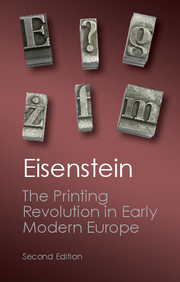Book contents
- Frontmatter
- Contents
- List of Illustrations and Maps
- Preface to the Second Edition
- Introduction
- THE PRINTING REVOLUTION IN EARLY MODERN EUROPE
- PART I THE EMERGENCE OF PRINT CULTURE IN THE WEST
- PART II INTERACTION WITH OTHER DEVELOPMENTS
- 5 The Permanent Renaissance: Mutation of a Classical Revival
- 6 Western Christendom Disrupted: Resetting the Stage for the Reformation
- 7 The Book of Nature Transformed: Printing and the Rise of Modern Science
- 8 Conclusion: Scripture and Nature Transformed
- Afterword: Revisiting the Printing Revolution
- Selected Reading
- Index
8 - Conclusion: Scripture and Nature Transformed
from PART II - INTERACTION WITH OTHER DEVELOPMENTS
Published online by Cambridge University Press: 05 October 2013
- Frontmatter
- Contents
- List of Illustrations and Maps
- Preface to the Second Edition
- Introduction
- THE PRINTING REVOLUTION IN EARLY MODERN EUROPE
- PART I THE EMERGENCE OF PRINT CULTURE IN THE WEST
- PART II INTERACTION WITH OTHER DEVELOPMENTS
- 5 The Permanent Renaissance: Mutation of a Classical Revival
- 6 Western Christendom Disrupted: Resetting the Stage for the Reformation
- 7 The Book of Nature Transformed: Printing and the Rise of Modern Science
- 8 Conclusion: Scripture and Nature Transformed
- Afterword: Revisiting the Printing Revolution
- Selected Reading
- Index
Summary
The elements which go into the making of “modernity” may be seen … first … in the sixteenth and seventeenth centuries. Some historians attributed the change to the liberation of men's minds during the Renaissance and the Reformation. Today many historians would be more likely to stress the conservatism of these two movements … Their emphasis tends instead to fall on … “the Scientific Revolution.”
By this is meant above all the imaginative achievements associated with the names of Copernicus, Galileo and Newton … Within the space of a century and a half a revolution had occurred in the way in which men regarded the universe. Most of this was made possible by the application of mathematics to the problems of the natural world …
All this is by now well known … though many of the details are still to be worked out … What is not clear is how it all came about.
This book has been aimed at developing a new strategy for handling the issues posed by the opening citation. It seems futile to argue over “the elements which go into the making of modernity,” for “modernity” itself is always in flux, always subject to definitions which have to be changed in order to keep up with changing times.
- Type
- Chapter
- Information
- The Printing Revolution in Early Modern Europe , pp. 286 - 312Publisher: Cambridge University PressPrint publication year: 2012



